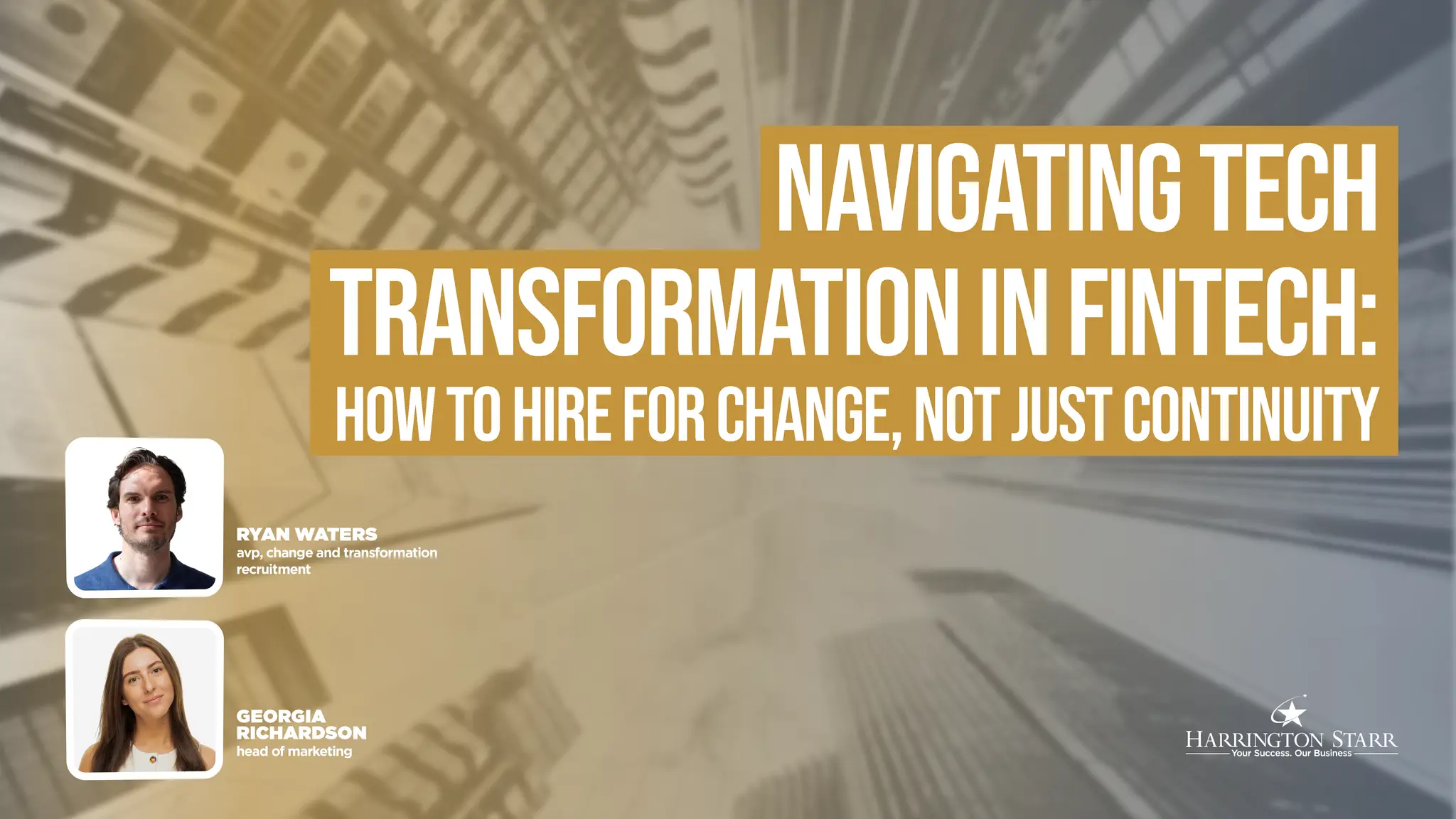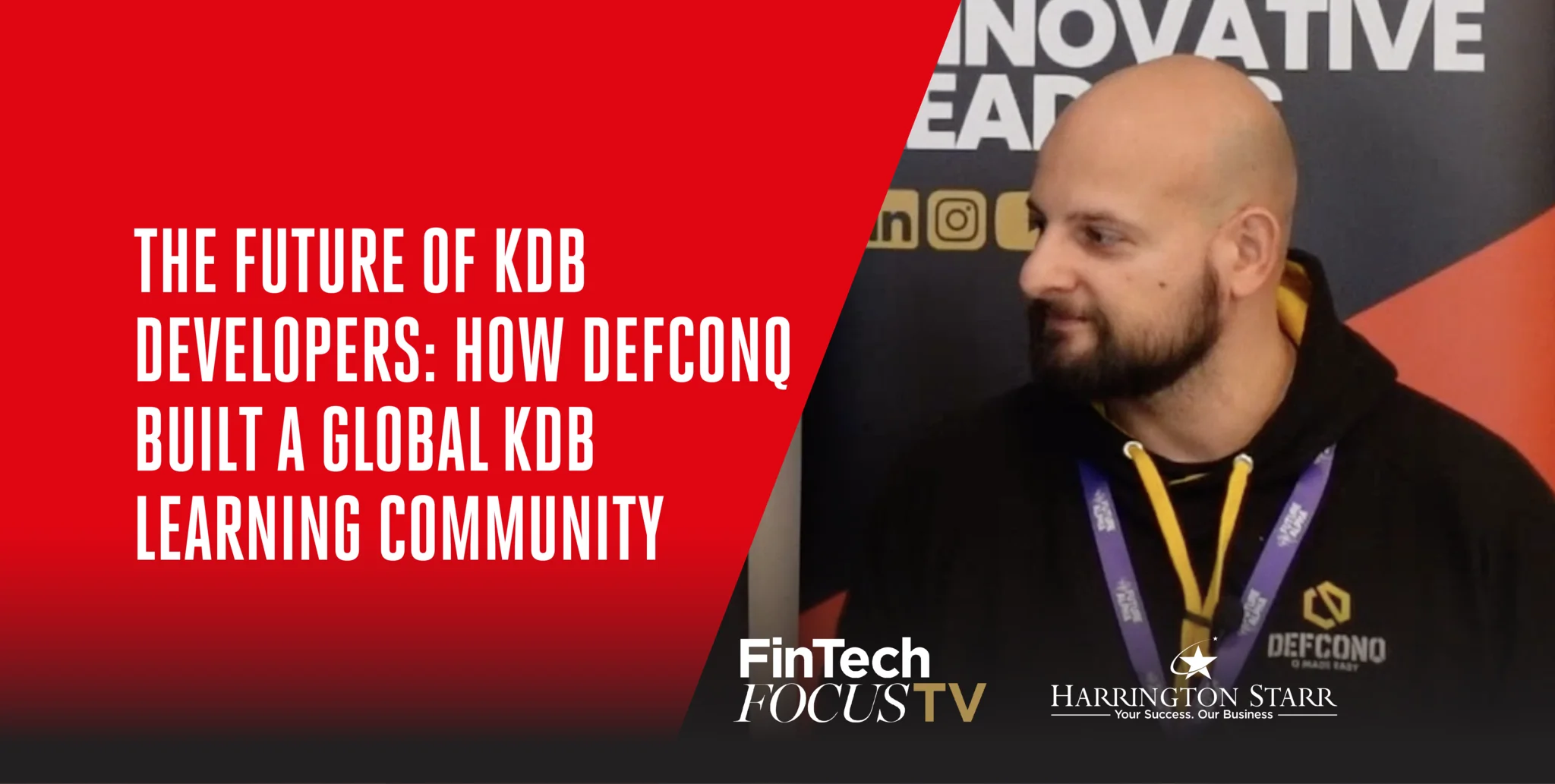Most FinTech leaders think transformation is a tech challenge. It isn’t, it’s a people challenge.
Your infrastructure might be cloud-native, your roadmap might be agile, but if you're still hiring like it's 2015, your transformation is already at risk. In London, New York, and across the financial world, businesses are discovering that successful change depends less on the tech stack and more on who’s delivering it.
So, how do you build a team that drives change, not just keeps the lights on?
This blog explores why hiring for change and transformation in FinTech requires a radically different mindset and how companies can build teams that accelerate, rather than hinder, innovation.
What’s Driving the Latest Wave of Change in Financial Technology?
Several forces are fuelling the current era of disruption in FinTech:
AI and Machine Learning
With the rise of generative AI and predictive analytics, firms in hubs like London and New York are rethinking everything from customer service automation to risk modelling. This requires not only data scientists and ML engineers but also product managers and delivery leads who understand how to align AI outputs with real business problems.
Regulatory Change
The push for more transparent reporting, ESG compliance, and real-time monitoring has added layers of complexity to systems and workflows. Regulatory tech (RegTech) is booming, but it requires a new class of tech-savvy compliance experts and platform integrators.
Cloud Migration
Legacy infrastructure is being phased out in favour of scalable, cloud-native environments. From Belfast to Boston, this shift brings demand for DevOps engineers, cloud architects, and specialists in hybrid integration.
Embedded Finance and Open Banking
Platforms are no longer standalone. Financial services are increasingly embedded within non-financial user journeys. This opens opportunities but also challenges for firms needing integration specialists and change managers.
Customer-Centric UX
Even B2B platforms are expected to deliver consumer-grade experiences. FinTech firms need product designers and front-end developers who understand both financial products and user behaviour.
Together, these shifts demand more than technical execution; they require strategic alignment between technology, operations, and business goals.
Why Traditional Hiring Models Break Down During Transformation
Most companies start their digital transformation journeys with good intentions. But many struggle to staff them effectively.
Here’s why:
Misalignment Between Business and Technology
Too often, tech teams are resourced without proper input from the business. This leads to miscommunication, poor prioritisation, and delivery that fails to meet commercial objectives.
Legacy Job Specs
Hiring for transformation using outdated role profiles results in poor-fit hires. A Business Analyst hired to document processes in a stable environment will likely fail when asked to shape workflows in an agile transformation.
Hybrid Skill Requirements
Roles in transformation demand people who can operate in ambiguity, influence stakeholders, and move between strategic thinking and execution. These hybrid profiles don’t often match what's in the HR system.
Speed and Flexibility
Transformation programmes move fast. Internal talent acquisition teams may be great at filling long-term roles but lack the agility to build multidisciplinary squads within tight delivery windows.
That’s why FinTechs looking to transform, whether in London, Chicago or San Francisco, must rethink not just who they hire, but how they hire.
What the Best FinTechs Are Doing Differently with Talent
Progressive financial technology companies are reimagining their approach to hiring for change and transformation:
1. Embedding Talent Early
Top FinTechs don’t wait until the discovery phase ends to bring in talent. They involve transformation consultants, Product Owners, and delivery leads from day one, shaping the strategy alongside leadership.
2. Thinking in Squads
Rather than hire roles in isolation, successful firms build squads that can deliver outcomes: think of a pod made up of a BA, developer, change manager, and QA analyst aligned to a business problem, not a department.
3. Partnering for Flexibility
Using trusted recruitment partners allows them to scale up or down quickly, especially in hybrid models where contract and perm hires are needed side by side.
4. Valuing Cultural Adaptability
Transformation isn’t just technical. It affects people, culture, and governance. That’s why adaptability, communication, and stakeholder engagement are prized alongside technical skills.
This approach ensures that transformation initiatives don’t just launch, they land.
Permanent vs. Contract: Building a Balanced Team for Change
One of the most common questions during a transformation programme is: Should we hire perm or contract?
The Case for Contractors
Contract professionals are ideal for:
- Time-bound delivery goals (e.g. MVPs, migrations)
- Specialist technical input (e.g. integration architects, platform SMEs)
- Transformation leadership (e.g. interim programme managers)
They offer speed, flexibility, and niche expertise, but must be well-integrated into teams to avoid siloed delivery.
The Case for Permanent Hires
Permanent team members are key when:
- You need long-term ownership of platforms
- Institutional knowledge is crucial
- Culture and continuity matter
Roles like product owners, heads of change, or strategic architects often fall here.
The Best of Both Worlds
Smart FinTechs, especially those in major hiring hubs like London, Dublin and New York, adopt a blended model. Contractors build momentum and hit early goals. Permanent hires scale, maintain, and iterate on that change.
Recruitment strategies that reflect this dual need are best placed to attract the right talent at the right time.
What’s the Cost of Getting FinTech Hiring Wrong?
Hiring mistakes during periods of transformation are more than an inconvenience; they’re a threat to business performance.
Misaligned or underqualified hires can stall delivery, derail programmes, and even increase regulatory or reputational risk. In financial services, where trust and timing are paramount, the consequences of bad hiring can be far-reaching.
Key risks include:
Regulatory non-compliance: A missed SME hire could result in your team misinterpreting new rules or delaying system upgrades required by regulators.
Reputational damage: Failed product launches or botched migrations, often the result of missing key roles, can damage trust with customers and partners.
Security vulnerabilities: Rushing to deploy without experienced DevSecOps talent can expose your systems to risks, especially during infrastructure transitions.
Internal culture impact: Bringing in the wrong transformation leader can erode morale, confuse, and create friction between teams and departments.
The cost of a bad hire isn’t just the replacement fee; it’s the compounded cost of lost time, rework, and damaged stakeholder confidence. In transformation, getting talent wrong is often more costly than moving slowly.
Avoiding the Innovation Talent Trap
Transformation is exciting. But chasing innovation without structure leads to what we call the "innovation talent trap."
Examples include:
- Hiring AI engineers before establishing a data governance framework
- Bringing in agile coaches without C-suite buy-in
- Investing in a new digital platform without experienced delivery leads
In all cases, the common failure point is not the tech, it’s the people and the sequencing.
Transformation hiring must be grounded in business outcomes. A strong recruitment partner can help ensure you hire for the right stage, not just the right buzzword.
How to Build a Talent Roadmap for Sustainable Change
If your FinTech is embarking on or accelerating transformation, consider this talent roadmap:
Step 1: Define the Desired Outcome
What are you trying to transform, customer experience, cost base, compliance?
Step 2: Identify Skills and Capabilities
Rather than job titles, list the outcomes each team needs to deliver. From there, map back to roles.
Step 3: Sequence the Hiring
- Early Phase: Product leaders, transformation consultants, architects
- Mid Phase: BAs, developers, QA, delivery managers
- Late Phase: Change leads, support analysts, trainers
Step 4: Balance Internal and External Talent
Identify where you’ll build in-house capabilities and where you’ll need short-term external expertise.
Step 5: Align With Culture
Ensure all hires, especially contractors, are aligned with the firm’s vision, ways of working, and stakeholder engagement style.
This roadmap turns talent from a delivery bottleneck into a competitive advantage.
The Role of Leadership in Successful Tech Transformation Hiring
Transformation hiring isn’t just an operational task; it’s a leadership responsibility.
In the most successful FinTech transformations, senior leadership actively shapes the hiring roadmap, ensuring it aligns with broader business objectives. When hiring is treated as a strategic lever, not a procurement task, the results are dramatically better.
Leadership can drive success by:
Owning the vision: Leaders who clearly articulate the “why” of transformation give hiring teams the context they need to find the right people.
Engaging early: Involving product leads, architects, and transformation sponsors in the hiring process ensures hires are aligned with delivery needs.
Removing roadblocks: Leadership can streamline decision-making, unblock headcount delays, and fast-track onboarding in high-priority areas.
Role modelling change culture: Transformation starts from the top. If leadership isn’t open to new thinking, new hires won’t be either.
When senior leaders see hiring as central to change, not peripheral, FinTech firms can move faster, hire smarter, and deliver transformation that sticks.
The Hidden Cost of Delayed Hiring in Transformation Projects
Many firms underestimate the cost of hiring delays during transformation. These include:
Delayed Launches
Missing a hire can delay an entire sprint, jeopardising regulatory deadlines or customer expectations.
Poor Quality Delivery
Under-resourced teams take shortcuts. This can lead to rework, compliance issues, or poor UX.
Burnout and Attrition
When teams are stretched, morale suffers and high-performers may leave.
Budget Overruns
The cost of fixing bad hiring decisions or missing contractors is often far greater than the initial recruitment investment.
Speed and quality in hiring are not opposites with the right partners, they reinforce each other.
Winning the FinTech Talent Race Requires a Transformation Mindset
Transformation in FinTech is no longer optional. It’s a necessity driven by technology, regulation, and customer demand. But no transformation succeeds without the right people.
That’s why leading firms, from Canary Wharf to Wall Street, are rethinking their recruitment strategies, hiring for change, not just continuity.
They’re prioritising adaptability over static skill sets, building blended teams of contractors and perm staff, and viewing recruitment as a strategic enabler of transformation, not an afterthought.
If your platform, process, or product is evolving, your people strategy needs to evolve too.
Ask yourself: Are we hiring for where we’ve been, or where we’re going?








